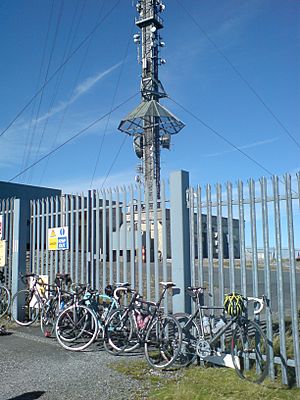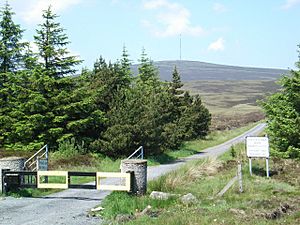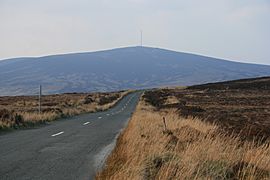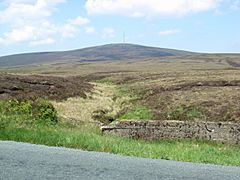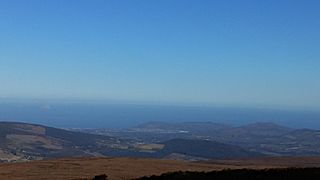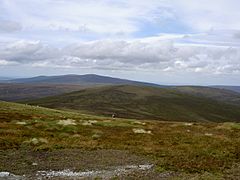Kippure facts for kids
Quick facts for kids Kippure |
|
|---|---|
| Cipiúr | |
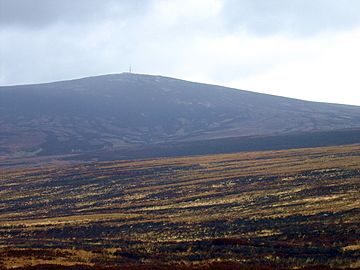
Kippure, southern slopes with the transmission mast visible on the summit
|
|
| Highest point | |
| Elevation | 757 m (2,484 ft) |
| Prominence | 262 m (860 ft) |
| Listing | County Top (Dublin), 100 Highest Irish Mountains, Marilyn, Hewitt, Arderin, Simm, Vandeleur-Lynam |
| Naming | |
| English translation | Kippure |
| Language of name | Irish |
| Geography | |
| Location | Wicklow & South Dublin Ireland |
| Parent range | Wicklow Mountains |
| OSI/OSNI grid | O1158215455 |
| Topo map | OSi Discovery 56 |
| Geology | |
| Mountain type | Pale grey fine to coarse-grained granite |
| Climbing | |
| Easiest route | Eastern path from the R115 Road (the "Military Road") |
Kippure (which is Cipiúr in Irish) is a mountain in Ireland. It stands at 757 meters (about 2,484 feet) tall. This makes it one of the highest peaks in the country. Kippure is located in the northern part of the Wicklow Mountains. It sits right on the border between Dublin and Wicklow counties.
Kippure is the highest point in Dublin County. Because it is so tall and close to Dublin city, its top is a very important place for transmission masts. These masts send out TV and radio signals and can be seen from far away. The mountain's slopes also feed into the Liffey Head Bog, which is where the River Liffey begins. You can easily reach the summit from the east by following a path off the R115 road, also known as the "Military Road."
Contents
What Does the Name Kippure Mean?
The name "Kippure" comes from a local way of saying the word. However, its exact meaning is not very clear. Some people think it might be linked to the Irish word "ciop," which means "stump," and "iúr," which means "yew tree." So, it could mean "stump of the yew."
It's unlikely that yew trees ever grew on a high, windy mountain like Kippure. But there might be a connection to a similar name in the valley below, where yew trees could have grown.
Where is Kippure Located?
Kippure is a large mountain that sits at the top of two main valleys. To the east is the valley of Glencree in Wicklow. This valley is also shaped by other mountains like Tonduff (642m), Maulin (570m), and Prince William's Seat (555m). To the north is the valley of Glenasmole in Dublin. This valley is formed with Seefingan (724m) and Corrig Mountain (617m).
South of Kippure, you'll find the high mountain pass called the Sally Gap, which is 503 meters (about 1,650 feet) high. From there, the Wicklow Mountains stretch southwards. They include peaks like Mullaghcleevaun (849m), Tonelagee (817m), and finally Lugnaquilla (925m), which is the highest mountain in Wicklow and the province of Leinster.
Kippure has two lakes on its north-east side, called Lough Bray Upper and Lough Bray Lower. Many rivers start on the slopes of Kippure. These include streams that flow into the River Liffey from the Liffey Head Bog and others that feed the River Dodder.
Kippure is also known as a "Marilyn." This means it stands out quite a bit from the land around it, by at least 100 meters (328 feet).
Kippure's Important Transmission Site
At the very top of Kippure, there is a tall mast that is 127 meters (about 417 feet) high. This mast sends out television and radio signals. It is the oldest TV transmission site in the Republic of Ireland.
Engineers first thought about using Kippure for radio signals in the mid-1950s. The Irish Board of Works built a road to the site in 1959. Then, a British company called Pye Ltd. started installing the transmitter equipment. By the summer of 1961, the mast was put up. They began testing it by showing pictures of Ireland and playing music.
Telefís Éireann, Ireland's national broadcaster, started sending TV signals from Kippure on December 31, 1961. This was a big moment for television in Ireland! Kippure was the first of five main transmitters to start working. The others were in places like Truskmore and Mount Leinster.
Later, in 1966, RTÉ Radio (which used to be called Radio Éireann) began broadcasting FM radio from Kippure. Stereo radio started in 1969.
Over time, Kippure's role in sending out TV and radio signals became less central. This was because new, more powerful transmitter sites were built in other areas, like Three Rock Mountain. These new sites offered better reception for many people.
Today, Kippure still broadcasts important services. It sends out the Irish DTT service called Saorview, which is how many people watch TV. It also broadcasts national FM radio stations and some commercial radio stations.
Current Broadcasts from Kippure
Kippure continues to be an active site for broadcasting. It sends out signals for:
- Terrestrial Television: This includes channels for Saorview, Ireland's digital TV service.
- Digital Radio: It also broadcasts digital radio signals.
- Analogue FM Radio: Many popular FM radio stations, like RTÉ Radio 1, RTÉ 2fm, and Today FM, are broadcast from Kippure.
Kippure also helps smaller relay transmitters, like those in Laragh and Rathnew, to send out TV signals to local areas.
Gallery
-
From the Sally Gap
-
A small stream that feeds the River Liffey
See also
 In Spanish: Cipiúr para niños
In Spanish: Cipiúr para niños



